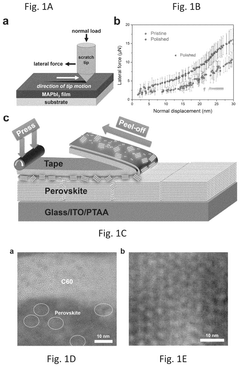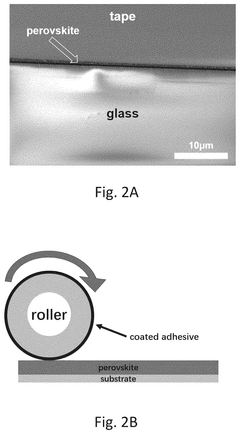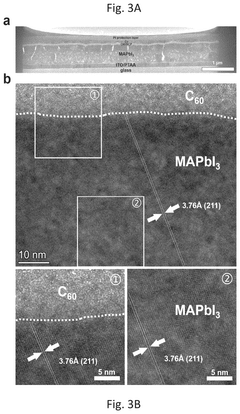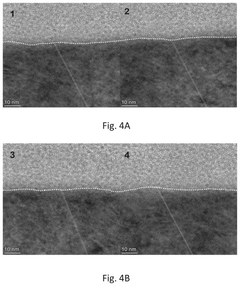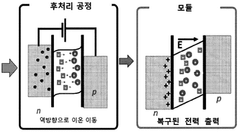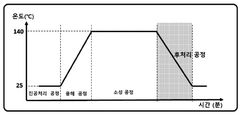How to Reduce Light-Induced Degradation in Perovskite Solar Cells
AUG 20, 20259 MIN READ
Generate Your Research Report Instantly with AI Agent
Patsnap Eureka helps you evaluate technical feasibility & market potential.
Perovskite LID Background and Objectives
Perovskite solar cells have emerged as a promising technology in the field of photovoltaics, offering high efficiency and low-cost manufacturing potential. However, light-induced degradation (LID) remains a significant challenge hindering their widespread adoption and long-term stability. This phenomenon, characterized by a gradual decrease in power conversion efficiency upon exposure to light, has been a focal point of research in recent years.
The evolution of perovskite solar cell technology can be traced back to 2009 when methylammonium lead halide perovskites were first used as sensitizers in dye-sensitized solar cells. Since then, rapid progress has been made in improving their efficiency, with current record efficiencies exceeding 25% for single-junction cells. However, the issue of stability, particularly light-induced degradation, has persisted throughout this development.
Light-induced degradation in perovskite solar cells is a complex process involving multiple mechanisms. These include ion migration, phase segregation, and the formation of defects within the perovskite crystal structure. The interplay between these factors leads to a gradual deterioration of the cell's performance over time, significantly impacting its operational lifespan and commercial viability.
Understanding and mitigating LID is crucial for the future of perovskite solar technology. The primary objective in addressing this challenge is to develop strategies that can effectively reduce or eliminate the degradation processes triggered by light exposure. This involves a multifaceted approach, encompassing materials engineering, device architecture optimization, and encapsulation techniques.
Key areas of focus in tackling LID include the development of more stable perovskite compositions, the engineering of interfaces to reduce ion migration, and the implementation of protective layers to shield the active material from excessive light and moisture exposure. Additionally, research is being conducted on the fundamental mechanisms of degradation at the atomic and molecular levels to inform more targeted solutions.
The ultimate goal of these efforts is to achieve perovskite solar cells with operational lifetimes comparable to or exceeding those of traditional silicon-based photovoltaics, typically 25-30 years. This would not only enhance the commercial viability of perovskite technology but also contribute significantly to the global transition towards sustainable energy sources.
As research in this field progresses, it is anticipated that breakthroughs in reducing light-induced degradation will pave the way for large-scale deployment of perovskite solar cells in various applications, from building-integrated photovoltaics to flexible and wearable electronics. The successful mitigation of LID will be a critical milestone in realizing the full potential of perovskite solar technology and its role in the future energy landscape.
The evolution of perovskite solar cell technology can be traced back to 2009 when methylammonium lead halide perovskites were first used as sensitizers in dye-sensitized solar cells. Since then, rapid progress has been made in improving their efficiency, with current record efficiencies exceeding 25% for single-junction cells. However, the issue of stability, particularly light-induced degradation, has persisted throughout this development.
Light-induced degradation in perovskite solar cells is a complex process involving multiple mechanisms. These include ion migration, phase segregation, and the formation of defects within the perovskite crystal structure. The interplay between these factors leads to a gradual deterioration of the cell's performance over time, significantly impacting its operational lifespan and commercial viability.
Understanding and mitigating LID is crucial for the future of perovskite solar technology. The primary objective in addressing this challenge is to develop strategies that can effectively reduce or eliminate the degradation processes triggered by light exposure. This involves a multifaceted approach, encompassing materials engineering, device architecture optimization, and encapsulation techniques.
Key areas of focus in tackling LID include the development of more stable perovskite compositions, the engineering of interfaces to reduce ion migration, and the implementation of protective layers to shield the active material from excessive light and moisture exposure. Additionally, research is being conducted on the fundamental mechanisms of degradation at the atomic and molecular levels to inform more targeted solutions.
The ultimate goal of these efforts is to achieve perovskite solar cells with operational lifetimes comparable to or exceeding those of traditional silicon-based photovoltaics, typically 25-30 years. This would not only enhance the commercial viability of perovskite technology but also contribute significantly to the global transition towards sustainable energy sources.
As research in this field progresses, it is anticipated that breakthroughs in reducing light-induced degradation will pave the way for large-scale deployment of perovskite solar cells in various applications, from building-integrated photovoltaics to flexible and wearable electronics. The successful mitigation of LID will be a critical milestone in realizing the full potential of perovskite solar technology and its role in the future energy landscape.
Market Analysis for Stable Perovskite PV
The perovskite solar cell market is experiencing rapid growth and attracting significant attention from both industry and academia. As a promising next-generation photovoltaic technology, perovskite solar cells offer high efficiency, low manufacturing costs, and versatile applications. However, the market for stable perovskite photovoltaics (PV) faces several challenges and opportunities.
The global solar PV market is projected to reach $200 billion by 2026, with perovskite solar cells expected to capture an increasing share. The demand for stable perovskite PV is driven by the need for more efficient and cost-effective renewable energy solutions. Key market segments include residential and commercial rooftop installations, building-integrated photovoltaics (BIPV), and portable electronics.
One of the primary market drivers for stable perovskite PV is the potential for higher efficiency compared to traditional silicon-based solar cells. Perovskite solar cells have demonstrated rapid efficiency improvements, with laboratory efficiencies now exceeding 25%. This high efficiency, combined with lower production costs, makes perovskite PV an attractive option for both large-scale and niche applications.
The market for stable perovskite PV is also influenced by the growing emphasis on sustainability and renewable energy adoption. Governments worldwide are implementing policies and incentives to promote clean energy technologies, creating a favorable environment for perovskite solar cell development and commercialization.
However, the market faces challenges related to long-term stability and durability. Light-induced degradation is a significant concern for perovskite solar cells, limiting their commercial viability. Addressing this issue is crucial for market growth and widespread adoption. Research efforts are focused on developing more stable perovskite materials and encapsulation techniques to enhance the longevity of these solar cells.
The competitive landscape for stable perovskite PV is evolving rapidly. Several startups and established companies are investing in research and development to overcome stability issues and bring perovskite solar cells to market. Collaborations between academic institutions and industry players are accelerating innovation and commercialization efforts.
Market analysts predict that as stability issues are resolved, perovskite solar cells could disrupt the traditional solar PV market. The potential for low-cost, high-efficiency solar panels could lead to increased adoption in both developed and developing countries, expanding the overall market for photovoltaic technologies.
The global solar PV market is projected to reach $200 billion by 2026, with perovskite solar cells expected to capture an increasing share. The demand for stable perovskite PV is driven by the need for more efficient and cost-effective renewable energy solutions. Key market segments include residential and commercial rooftop installations, building-integrated photovoltaics (BIPV), and portable electronics.
One of the primary market drivers for stable perovskite PV is the potential for higher efficiency compared to traditional silicon-based solar cells. Perovskite solar cells have demonstrated rapid efficiency improvements, with laboratory efficiencies now exceeding 25%. This high efficiency, combined with lower production costs, makes perovskite PV an attractive option for both large-scale and niche applications.
The market for stable perovskite PV is also influenced by the growing emphasis on sustainability and renewable energy adoption. Governments worldwide are implementing policies and incentives to promote clean energy technologies, creating a favorable environment for perovskite solar cell development and commercialization.
However, the market faces challenges related to long-term stability and durability. Light-induced degradation is a significant concern for perovskite solar cells, limiting their commercial viability. Addressing this issue is crucial for market growth and widespread adoption. Research efforts are focused on developing more stable perovskite materials and encapsulation techniques to enhance the longevity of these solar cells.
The competitive landscape for stable perovskite PV is evolving rapidly. Several startups and established companies are investing in research and development to overcome stability issues and bring perovskite solar cells to market. Collaborations between academic institutions and industry players are accelerating innovation and commercialization efforts.
Market analysts predict that as stability issues are resolved, perovskite solar cells could disrupt the traditional solar PV market. The potential for low-cost, high-efficiency solar panels could lead to increased adoption in both developed and developing countries, expanding the overall market for photovoltaic technologies.
Current LID Challenges in Perovskite Cells
Light-induced degradation (LID) remains a significant challenge in the development and commercialization of perovskite solar cells. Despite their promising efficiency and low-cost production, perovskite solar cells suffer from stability issues, particularly when exposed to light. This phenomenon, known as LID, leads to a gradual decrease in power conversion efficiency over time, limiting the long-term performance and reliability of these devices.
One of the primary mechanisms contributing to LID in perovskite solar cells is the formation of defects within the perovskite crystal structure. When exposed to light, the perovskite material undergoes photochemical reactions that can lead to the creation of point defects, such as vacancies and interstitials. These defects act as recombination centers for charge carriers, reducing the overall efficiency of the solar cell.
Another significant challenge is the migration of ions within the perovskite layer under illumination. This ion migration can lead to the accumulation of charges at interfaces, causing band bending and altering the device's electronic properties. The movement of ions, particularly halide ions, can also result in the formation of trap states and contribute to the degradation of the perovskite material itself.
The presence of oxygen and moisture further exacerbates the LID problem in perovskite solar cells. When exposed to light, these environmental factors can trigger oxidation reactions and the formation of volatile species, leading to irreversible degradation of the perovskite layer. This is particularly problematic for devices that are not adequately encapsulated or exposed to ambient conditions.
Interfacial degradation is another critical aspect of LID in perovskite solar cells. The interfaces between the perovskite layer and the charge transport layers are susceptible to light-induced chemical reactions and physical changes. These interfacial degradation processes can lead to increased charge recombination, reduced charge extraction efficiency, and overall performance deterioration.
The stability of the perovskite material itself under prolonged light exposure is also a major concern. Some perovskite compositions, particularly those containing volatile organic components, are prone to phase segregation and decomposition when subjected to continuous illumination. This can result in the formation of secondary phases with different optoelectronic properties, further compromising the device performance.
Addressing these LID challenges requires a multifaceted approach, combining materials engineering, device architecture optimization, and encapsulation strategies. Researchers are actively exploring various methods to mitigate LID, including the development of more stable perovskite compositions, the incorporation of passivation layers, and the use of advanced encapsulation techniques to protect the devices from environmental factors.
One of the primary mechanisms contributing to LID in perovskite solar cells is the formation of defects within the perovskite crystal structure. When exposed to light, the perovskite material undergoes photochemical reactions that can lead to the creation of point defects, such as vacancies and interstitials. These defects act as recombination centers for charge carriers, reducing the overall efficiency of the solar cell.
Another significant challenge is the migration of ions within the perovskite layer under illumination. This ion migration can lead to the accumulation of charges at interfaces, causing band bending and altering the device's electronic properties. The movement of ions, particularly halide ions, can also result in the formation of trap states and contribute to the degradation of the perovskite material itself.
The presence of oxygen and moisture further exacerbates the LID problem in perovskite solar cells. When exposed to light, these environmental factors can trigger oxidation reactions and the formation of volatile species, leading to irreversible degradation of the perovskite layer. This is particularly problematic for devices that are not adequately encapsulated or exposed to ambient conditions.
Interfacial degradation is another critical aspect of LID in perovskite solar cells. The interfaces between the perovskite layer and the charge transport layers are susceptible to light-induced chemical reactions and physical changes. These interfacial degradation processes can lead to increased charge recombination, reduced charge extraction efficiency, and overall performance deterioration.
The stability of the perovskite material itself under prolonged light exposure is also a major concern. Some perovskite compositions, particularly those containing volatile organic components, are prone to phase segregation and decomposition when subjected to continuous illumination. This can result in the formation of secondary phases with different optoelectronic properties, further compromising the device performance.
Addressing these LID challenges requires a multifaceted approach, combining materials engineering, device architecture optimization, and encapsulation strategies. Researchers are actively exploring various methods to mitigate LID, including the development of more stable perovskite compositions, the incorporation of passivation layers, and the use of advanced encapsulation techniques to protect the devices from environmental factors.
Existing LID Mitigation Strategies
01 Composition modifications to enhance stability
Improving the stability of perovskite solar cells against light-induced degradation by modifying the composition of the perovskite material. This includes incorporating additives, dopants, or using mixed-cation or mixed-halide perovskites to enhance the structural stability and resistance to photo-degradation.- Encapsulation techniques to prevent light-induced degradation: Various encapsulation methods are employed to protect perovskite solar cells from light-induced degradation. These techniques involve using barrier materials, sealants, or multi-layer structures to prevent moisture and oxygen ingress, which can accelerate degradation when exposed to light. Effective encapsulation can significantly extend the operational lifetime of perovskite solar cells under illumination.
- Compositional engineering of perovskite materials: Researchers are focusing on modifying the composition of perovskite materials to enhance their stability under light exposure. This includes incorporating mixed cations or anions, doping with specific elements, or developing new perovskite formulations that are inherently more resistant to light-induced degradation. These compositional changes aim to improve the structural stability and optoelectronic properties of the perovskite layer.
- Interface engineering and charge transport layers: Optimizing the interfaces between the perovskite layer and charge transport layers is crucial for mitigating light-induced degradation. This involves developing novel electron and hole transport materials, implementing buffer layers, or modifying existing interfaces to reduce charge recombination and ion migration under illumination. Improved interface engineering can lead to more stable and efficient perovskite solar cells.
- Light management strategies: Implementing advanced light management techniques can help reduce the impact of light-induced degradation in perovskite solar cells. This includes using optical filters, developing anti-reflection coatings, or incorporating photonic structures to optimize light absorption while minimizing harmful UV exposure. These strategies aim to enhance cell efficiency while protecting the perovskite layer from degradation.
- In-situ healing and self-repair mechanisms: Research is being conducted on developing perovskite solar cells with in-situ healing or self-repair capabilities to counteract light-induced degradation. This involves incorporating additives or designing the perovskite structure to allow for spontaneous recovery of degraded areas when the cell is not under illumination. These mechanisms aim to extend the operational lifetime of perovskite solar cells by reversing some of the light-induced damage.
02 Encapsulation and protective layers
Developing effective encapsulation techniques and protective layers to shield the perovskite material from moisture, oxygen, and excessive light exposure. This approach involves the use of various barrier materials and encapsulation methods to prevent environmental factors from triggering light-induced degradation.Expand Specific Solutions03 Interface engineering
Optimizing the interfaces between the perovskite layer and charge transport layers to reduce recombination and improve charge extraction. This includes developing novel interfacial materials and treatments to minimize defects and enhance the overall stability of the device under light exposure.Expand Specific Solutions04 Light management strategies
Implementing light management techniques to reduce the intensity of light reaching the perovskite layer while maintaining high efficiency. This involves the use of optical filters, light-scattering layers, or other photonic structures to mitigate the impact of intense light on the perovskite material.Expand Specific Solutions05 In-situ healing and self-repair mechanisms
Developing perovskite materials with intrinsic self-healing properties or incorporating additives that promote in-situ repair of light-induced defects. This approach aims to counteract the degradation process by enabling the material to recover from photo-induced damage during operation.Expand Specific Solutions
Key Players in Perovskite PV Research
The competitive landscape for reducing light-induced degradation in perovskite solar cells is evolving rapidly, with the industry in a growth phase characterized by increasing market size and advancing technological maturity. Major players like Trina Solar, HANWHA SOLUTIONS, and EneCoat Technologies are driving innovation in this field. The market is expanding as perovskite technology gains traction for its potential to enhance solar cell efficiency. Research institutions such as Kyoto University and EPFL are collaborating with industry leaders to overcome stability challenges. While the technology is not yet fully commercialized, significant progress in mitigating light-induced degradation is being made through materials engineering and device architecture optimization, indicating a maturing technological landscape.
Trina Solar Co., Ltd.
Technical Solution: Trina Solar has developed a multi-pronged approach to reduce light-induced degradation in perovskite solar cells. Their strategy includes optimizing the perovskite composition through careful control of the precursor ratios and incorporation of additives to enhance crystallinity and reduce defect density. They have also focused on improving the charge transport layers, particularly developing novel hole transport materials that are more stable under illumination. Trina Solar has implemented advanced encapsulation techniques to protect the perovskite layer from moisture and oxygen, which can exacerbate light-induced degradation[4]. Furthermore, they have explored the use of UV-filtering coatings on the front glass to reduce the impact of high-energy photons on the perovskite material[5].
Strengths: Comprehensive approach addressing multiple aspects of light-induced degradation, from material composition to device architecture. Strong industrial focus on scalable solutions. Weaknesses: Potential trade-offs between stability improvements and initial device efficiency.
HANWHA SOLUTIONS CORP.
Technical Solution: Hanwha Solutions has focused on developing advanced encapsulation and barrier technologies to mitigate light-induced degradation in perovskite solar cells. Their approach includes the use of multi-layer barrier films that effectively prevent moisture and oxygen ingress while maintaining high transparency. They have also developed specialized edge sealants that provide superior protection against environmental factors. Hanwha's research has led to the implementation of novel light management strategies, such as the integration of luminescent down-shifting layers, which can reduce the impact of high-energy photons on the perovskite material[6]. Additionally, they have explored the use of dopant engineering in the perovskite layer to enhance its intrinsic stability under illumination[7].
Strengths: Strong focus on practical, industry-ready solutions for enhancing long-term stability. Expertise in large-scale manufacturing of solar technologies. Weaknesses: Potential increase in module cost due to advanced encapsulation materials.
Innovative Anti-LID Techniques
Surface treatments for perovskite films to improve efficiency/stability of resulting solar cells
PatentPendingUS20250113722A1
Innovation
- A surface treatment method involving adhesive tape or mechanical polishing is used to remove surface defect layers from polycrystalline perovskite films, enhancing stability and efficiency by eliminating nanocrystals and amorphous regions.
Post-treatment method for preventing cell degradation of perovskite-based solar cell module and perovskite-based solar cell module treated thereby
PatentWO2025143620A1
Innovation
- A post-treatment method involving light irradiation and bias application after the lamination process to reposition ionic defects back to the bulk region, restoring the internal electric field and improving photovoltaic performance.
Environmental Impact Assessment
The environmental impact assessment of perovskite solar cells, particularly in the context of reducing light-induced degradation, is a critical aspect of their development and deployment. Perovskite solar cells have shown great promise in terms of efficiency and cost-effectiveness, but their environmental implications must be carefully considered.
One of the primary environmental concerns associated with perovskite solar cells is the use of lead in their composition. While efforts are being made to develop lead-free alternatives, the current generation of high-performance perovskite solar cells still relies on lead-based materials. The potential for lead leaching into the environment during the manufacturing process, use phase, or end-of-life disposal poses significant ecological and health risks.
The light-induced degradation of perovskite solar cells also has environmental implications. As these cells degrade over time due to exposure to light, their efficiency decreases, potentially leading to a shorter lifespan compared to traditional silicon-based solar cells. This shorter lifespan could result in increased waste generation and the need for more frequent replacements, which in turn increases the overall environmental footprint of the technology.
However, efforts to reduce light-induced degradation could have positive environmental impacts. Improved stability and longevity of perovskite solar cells would lead to reduced waste generation and a lower overall environmental impact over the lifecycle of the technology. Additionally, more stable perovskite solar cells could compete more effectively with traditional silicon-based cells, potentially accelerating the adoption of solar energy and contributing to the reduction of greenhouse gas emissions from energy production.
The manufacturing process of perovskite solar cells also warrants environmental consideration. While perovskite cells can be produced using less energy-intensive methods compared to silicon cells, the use of solvents and other chemicals in their production raises concerns about potential environmental contamination. Developing greener synthesis methods and exploring the use of more environmentally friendly materials could significantly improve the overall environmental profile of perovskite solar cell technology.
In terms of end-of-life management, the recyclability of perovskite solar cells is an important factor. Current research is focusing on developing recycling methods to recover valuable materials from degraded cells, which could help mitigate some of the environmental concerns associated with their disposal. Effective recycling strategies could also contribute to a more circular economy approach in the solar energy sector.
One of the primary environmental concerns associated with perovskite solar cells is the use of lead in their composition. While efforts are being made to develop lead-free alternatives, the current generation of high-performance perovskite solar cells still relies on lead-based materials. The potential for lead leaching into the environment during the manufacturing process, use phase, or end-of-life disposal poses significant ecological and health risks.
The light-induced degradation of perovskite solar cells also has environmental implications. As these cells degrade over time due to exposure to light, their efficiency decreases, potentially leading to a shorter lifespan compared to traditional silicon-based solar cells. This shorter lifespan could result in increased waste generation and the need for more frequent replacements, which in turn increases the overall environmental footprint of the technology.
However, efforts to reduce light-induced degradation could have positive environmental impacts. Improved stability and longevity of perovskite solar cells would lead to reduced waste generation and a lower overall environmental impact over the lifecycle of the technology. Additionally, more stable perovskite solar cells could compete more effectively with traditional silicon-based cells, potentially accelerating the adoption of solar energy and contributing to the reduction of greenhouse gas emissions from energy production.
The manufacturing process of perovskite solar cells also warrants environmental consideration. While perovskite cells can be produced using less energy-intensive methods compared to silicon cells, the use of solvents and other chemicals in their production raises concerns about potential environmental contamination. Developing greener synthesis methods and exploring the use of more environmentally friendly materials could significantly improve the overall environmental profile of perovskite solar cell technology.
In terms of end-of-life management, the recyclability of perovskite solar cells is an important factor. Current research is focusing on developing recycling methods to recover valuable materials from degraded cells, which could help mitigate some of the environmental concerns associated with their disposal. Effective recycling strategies could also contribute to a more circular economy approach in the solar energy sector.
Commercialization Roadmap
The commercialization roadmap for reducing light-induced degradation in perovskite solar cells involves several key stages and considerations. Initially, research and development efforts must focus on optimizing the perovskite material composition and device architecture to enhance stability under prolonged light exposure. This phase may take 2-3 years of intensive laboratory work and collaboration with academic institutions.
Following successful lab-scale demonstrations, the next crucial step is scaling up the production process. This involves developing manufacturing techniques that can maintain the improved stability of perovskite cells while increasing production volume. Pilot production lines should be established to test and refine these processes, which may require an additional 1-2 years.
Concurrently, efforts must be made to address regulatory and certification requirements. This includes obtaining necessary safety certifications and ensuring compliance with environmental standards. Given the novelty of perovskite technology, this process may take 1-2 years and involve close cooperation with regulatory bodies.
Market entry strategies should be developed during this time, focusing initially on niche applications where the unique properties of perovskite cells offer significant advantages. These could include building-integrated photovoltaics or portable electronic devices. As production scales up and costs decrease, expansion into broader markets can be pursued.
Partnerships with established solar panel manufacturers and distributors will be crucial for market penetration. These collaborations can provide access to existing supply chains and customer bases, accelerating commercialization. Negotiations and partnership formations may take 6-12 months.
Investment in quality control and long-term reliability testing is essential throughout the commercialization process. This includes establishing rigorous testing protocols and potentially setting up dedicated testing facilities. Continuous monitoring and improvement of product performance in real-world conditions will be necessary to build consumer trust.
The final stage involves ramping up to full-scale commercial production. This may require significant capital investment in manufacturing facilities and equipment. Depending on market demand and available resources, this phase could take 1-2 years to reach substantial production volumes.
Overall, the commercialization roadmap from initial R&D to full-scale production is estimated to span 5-7 years. However, this timeline can be influenced by factors such as technological breakthroughs, regulatory changes, and market dynamics. Continuous adaptation and refinement of the commercialization strategy will be necessary to navigate these challenges and capitalize on emerging opportunities in the rapidly evolving solar energy market.
Following successful lab-scale demonstrations, the next crucial step is scaling up the production process. This involves developing manufacturing techniques that can maintain the improved stability of perovskite cells while increasing production volume. Pilot production lines should be established to test and refine these processes, which may require an additional 1-2 years.
Concurrently, efforts must be made to address regulatory and certification requirements. This includes obtaining necessary safety certifications and ensuring compliance with environmental standards. Given the novelty of perovskite technology, this process may take 1-2 years and involve close cooperation with regulatory bodies.
Market entry strategies should be developed during this time, focusing initially on niche applications where the unique properties of perovskite cells offer significant advantages. These could include building-integrated photovoltaics or portable electronic devices. As production scales up and costs decrease, expansion into broader markets can be pursued.
Partnerships with established solar panel manufacturers and distributors will be crucial for market penetration. These collaborations can provide access to existing supply chains and customer bases, accelerating commercialization. Negotiations and partnership formations may take 6-12 months.
Investment in quality control and long-term reliability testing is essential throughout the commercialization process. This includes establishing rigorous testing protocols and potentially setting up dedicated testing facilities. Continuous monitoring and improvement of product performance in real-world conditions will be necessary to build consumer trust.
The final stage involves ramping up to full-scale commercial production. This may require significant capital investment in manufacturing facilities and equipment. Depending on market demand and available resources, this phase could take 1-2 years to reach substantial production volumes.
Overall, the commercialization roadmap from initial R&D to full-scale production is estimated to span 5-7 years. However, this timeline can be influenced by factors such as technological breakthroughs, regulatory changes, and market dynamics. Continuous adaptation and refinement of the commercialization strategy will be necessary to navigate these challenges and capitalize on emerging opportunities in the rapidly evolving solar energy market.
Unlock deeper insights with Patsnap Eureka Quick Research — get a full tech report to explore trends and direct your research. Try now!
Generate Your Research Report Instantly with AI Agent
Supercharge your innovation with Patsnap Eureka AI Agent Platform!
